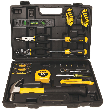Painting ceilings can provide some rather unique challenges, the most obvious of which is that if you aren't particularly careful you can end up with paint dripping into your face and eyes. That being said, if you follow these simple steps, you will not only learn how to paint the ceiling properly, but also avoid most of the mess that you could expect otherwise. Luckily, the process isn't all that difficult. Time consuming yes, but not difficult.
- Gather your tools. In order to paint your ceiling, you will need to gather together all of the tools you are going to use. Typically this will be things like drop cloths, paint brushes, rollers (particularly thick napped ones for textured ceilings), extension handles for the paint rollers, ladders, and a painting tray. Furthermore, you will need to have the proper paint to use, primer to help hold the paint, as well as painters tape to help protect objects and areas that you don't want painted. Depending on the size of the ceiling you may also want to try using a paint sprayer to help
- Prepare the work area. Before you start slapping paint on the ceiling, you need to prep y our work area. This means that you need to remove as much of the furniture in the room as possible. Anything that you can't remove needs to be covered with a drop cloth to protect it from any paint that could potentially spill. Once you have the drop cloths in place, clean the ceiling so that you have a dust and dirt free surface to work with. If necessary, you may want to also wash the ceiling, and allow it to dry before you finish prepping the area. Furthermore, you will also want to use some painters tape around things like lights, and have it help hold up newspaper on any skylights that you may have.
- Prime the ceiling. Using the paint sprayer (if you have one) or the paint brushes and rollers, prime your ceiling. Paint this in much the same manner that you would the walls with one minor difference. That difference is that you will want to use as little primer as possible so that it won't drip. Start by cutting in from the outside of the ceiling, and work towards the middle for at least three or four inches. This will give you a bit breathing room so that you don't accidentally paint the walls. Once you have primed the ceiling, allow it to dry, and then put on another coat, being sure that you allow it to dry completely prior to proceeding to the next step.
- Cut in. Since the ceiling is now primed, you can begin the actual painting process. As with the primer, you will want to initially cut in from the outer edges using a paint brush. Make sure that you don't put too much paint on the brush, or it will end up dripping down your arm or even on your face.
- Paint it. When you have done that, you will then want to use paint brushes, rollers, or a paint sprayer to ensure that you put it on smoothly and evenly. As you did when you put the primer on, and when you also cut in, you will want to use the least amount of paint possible so that it doesn't end up dripping down the walls, onto the floors, or on you. This will also help prevent any "stalagmites" of paint from forming.
- Dry, and double check. Allow the paint to completely dry, and then look over your work. Repeat the painting process described in steps four and five as often as necessary until you have the look and color that you want on your ceiling. Do not rush the project, and be sure that you allow the paint to completely dry between each coat.
Once you have finished, and are satisfied with the way that your ceiling looks, you are basically done. All you really need to do now is clean the area, and put everything away. Pay particular attention to any paint that may have spilled, and clean it up as quickly as you can. In addition you will also want to clean your tools so that you don't damage them, and properly store any excess paint that you may have remaining.
Author Bio
Lee Wyatt
Contributor of numerous Tips.Net articles, Lee Wyatt is quickly becoming a regular "Jack of all trades." He is currently an independent contractor specializing in writing and editing. Contact him today for all of your writing and editing needs! Click here to contact. Learn more about Lee...
Preparing for Retirement
Preparing for retirement is an important step, and one that shouldn't be put off forever. While it is true that it is ...
Discover More
Fixing a Window that Won't Roll Up
Let's face facts...windows are great, wonderful things that will allow you to determine whether you want to face the ...
Discover More
Disinfecting Your Kitchen Sponge
Most people don't stop to think about cleaning their cleaning tools, and that is a rather sad state of affairs. The truth ...
Discover More
More Home Improvement Tips
Mixing Paint
Have you ever noticed how expensive a painting project can be? There are several different methods you can use to save ...
Discover More
Painting in Tight Corners
If you are painting walls that meet in a corner two different colors, it's best to use painter's tape. But if your walls ...
Discover More
Choosing a Paint Roller
A paint roller is an extremely useful tool for any home improvement or home decorating project. Here are some guidelines ...
Discover More

Comments